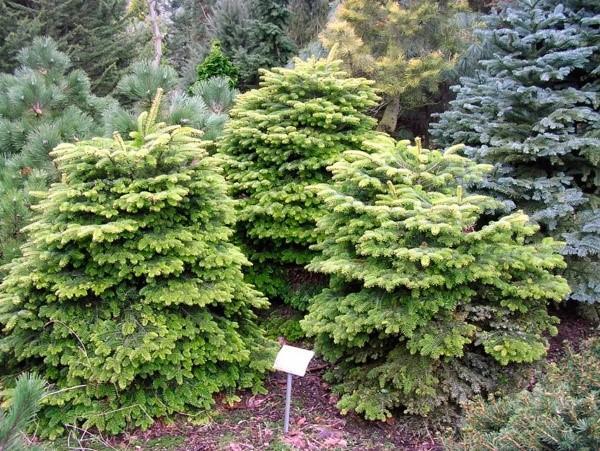Types of fir for cultivation in the southern and middle lane
 The luxurious crown, fluffy needles and unpretentiousness of the fir make it the most desirable coniferous plant. If you have not yet decided what to plant on your site, we suggest that you find out which types of fir are some of the most unpretentious and beautiful.
The luxurious crown, fluffy needles and unpretentiousness of the fir make it the most desirable coniferous plant. If you have not yet decided what to plant on your site, we suggest that you find out which types of fir are some of the most unpretentious and beautiful.
Types of fir for growing on a personal plot in the middle lane
Fir trees look good both in group compositions and in individual planting. They can become a New Year tree or highlight the beauty of a flower bed. Among the fir trees, there are proud tall species for city parks or large suburban areas. If you are the owner of a modest summer cottage, even there you can find a place for these conifers by choosing compact dwarf varieties.
One of the most beautiful and sought-after species that winter well in our area include the following fir:
- Siberian;
- Korean;
- single color;
- subalpine;
- Arizona;
- Caucasian.
Siberian fir
One of the most frost-resistant and shade-tolerant species, which even the name of the plant confirms. It grows best in conditions as close to natural as possible. In the city, where gas pollution is increased, the fir will be sick. The maximum tree height is 60 m with a crown diameter of up to 2 m. It is a slender tree with a narrow cone-shaped crown and thin branches. The buds are green or purple.
For the southern regions it is worth choosing more "gentle" and thermophilic varieties. Siberian fir will be too hot and dry there, which will immediately affect the appearance of the needles.
Korean fir
This is one of the richest varieties of species. Among them there are both tall and undersized dwarf firs, as well as plants with unusual blue needles. The crown of the Korean fir is wide, reminiscent of a pyramid. The needles are dense, bright green. The buds have a very beautiful purple color and grow vertically on short stalks. Winters well, but does not tolerate drought.
Fir monochromatic
It is difficult to confuse it with others: it is a tall tree with a long, up to 7 cm, green needles with a bluish bloom. Moreover, its aroma is more like lemon. The cones are dark purple. One of the most drought-resistant firs, which makes it possible to grow ephedra both in the middle lane and in the southern regions.
Monochrome fir is the most sun-loving, in the shade it brightens and begins to ache.
Arizona fir
Previously, this plant was considered one of the subalpine fir species due to the fact that they are very similar. But today the Arizona fir is a separate species, more compact, with a height of up to 15 m and high winter hardiness. Her cones are smaller, but the needles have a beautiful color, with a silvery-blue tint.
Types of drought-resistant fir for cultivation in the southern regions
Among the conifers that grow better in milder and warmer climates, firs are popular:
- Nordman;
- balsamic;
- subalpine.
Nordman fir
A tall tree with an average growth of about 60 m with a thick trunk up to 3 m in diameter. The crown is in the form of a cone, with densely arranged branches. The needles are dark green, with a glossy shade on top, and with a matte shade on the reverse side, the cones are brown.
Balsam fir
Among other types, the most short-lived. There are varieties that can grow up to 40 m in height, and there are also compact fir no more than 0.5 m high. The crown is pyramidal, regular, with lush green needles, brown cones. Grows best in partial shade and in moist soil.
Subalpine fir
It has the most interesting crown - it has the shape of a narrow cone. The height of the tree does not exceed 30 m, while the trunk diameter is only 60 cm. The needles are green-blue, the cones are purple. The species is very picky about moisture and does not like urban conditions, but it grows well in the shade.